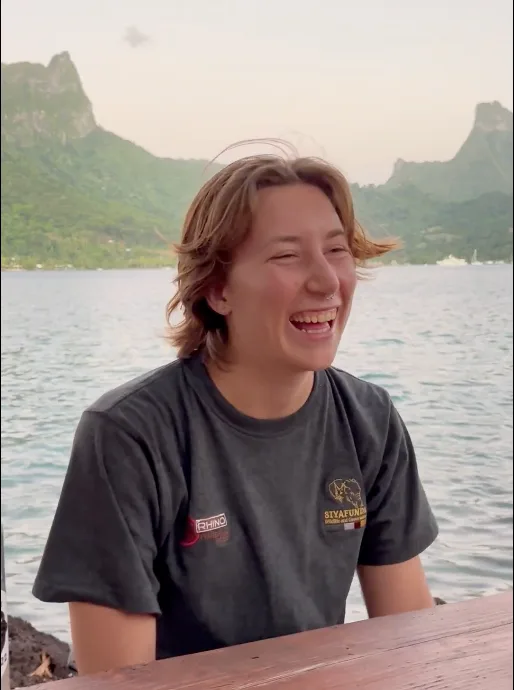Programs Blog
Charlotte On Copepods, Touring Mo’orea

Date: May 28, 2025
Time: 2110
Location: Gump Marine Station, Mo‘orea
Weather: 76˚ F, 8 kts southeasterly
Below is an excerpt from an interview with Charlotte Subak, Mount Holyoke College.
What is happening with your science project right now?
We’ve written a full draft of our final manuscript. We turned that in to (Professor) Sarah and (postdoc) Kayla and they gave us very, very thorough feedback, lots of comments. So we just spent the last few hours since lunch looking through those comments, making changes, making revisions, editing, restructuring some things, and then fine-tuning the language and adjusting some of our figures.
My group’s research is looking at the way chlorophyll-a concentrations at the deep chlorophyll maximum impact the diel vertical migration of copepods. So basically what we were expecting to see is that as chlorophyll-a concentrations at the deep chlorophyll maximimum increase we would see greater rates of diurnal migration. We measure this diel vertical migration by looking at the difference in diversity of day and night neuston tows. We measure diversity through several different parameters, but we’re using richness (number of different species), relative abundance, and some statistical tests. We’re finding that there’s not much relationship at all between these things, which suggests that chlorophyll-a is less of a driving factor than we previously thought in diurnal migration. Ours is just one small study with a lot of confounding variables, but this is really interesting because chlorophyll-a in the ocean is going to be changing a lot as the climate continues to change. We know that as copepods move up and down in the water column, they sequester a lot of carbon.
Could you tell us about our car tour around the island today?
This was so amazing. It was really awesome and so meaningful, and I learned so many things. I feel like I got so much out of it. Herehia was our local guide. She was so knowledgeable and you got the sense that she could have talked about these things for hours and hours and never run out of things to say. She basically took us around, and we stopped at a couple different spots on the island that she had picked out. She taught us a lot about the Tahitian language, what things actually mean. One of the highlights was learning that some of the basic phrases we’ve been using, io ora na as meaning ‘hello’ and mauruuru as meaning ‘thank you,’ actually have much deeper and more complex meanings.
We stopped at the marae (a sacred place, this one built of stone dating to at least the late 1600s?), named I Te Tiiroa, which was really amazing. I felt so lucky to be there. To have the privilege of being in that space with Herehia, learning about the importance of those spaces, what they meant to the communities here historically. That was really powerful.
One of the things we learned about were the taura, symbols, animals that individual families have that they associate with and are very meaningful to them. Herehia was explaining to us how these are passed down through the generations. You can kind of find your own. Even with people who don’t have that connection with their ancestors—because so much of their history has been lost because of the really destructive history of colonization here–it’s still possible for people and families to find their way back to these through practices of meditation and talking to people and through dreams. It was so interesting and beautiful how those taura persist through the generations.


Recent Posts from the Ships
- Ocean Classroom 2024-A collaborative high school program with Proctor Academy
- Collaborations and Long-term Commitments: SEA’s Caribbean Reef Program Sets a Course for Coastal Programs that Compliment Shipboard Experiences.
- Sea Education Association students prepare for life underway using state of the art nautical simulation from Wartsila Corporation.
- SEA Writer 2022, Magazines From the Summer SEA Quest Students
- Technology@SEA: Upgrades Allow Insight into Ocean Depths
Programs
- Gap Year
- Ocean Exploration
- High School
- Science at SEA
- SEA Expedition
- SEAScape
- Pre-College
- Proctor Ocean Classroom
- Protecting the Phoenix Islands
- SPICE
- Stanford@SEA
- Undergraduate
- Climate and Society
- Climate Change and Coastal Resilience
- Coral Reef Conservation
- Marine Biodiversity and Conservation
- MBL
- Ocean Exploration: Plastics
- Ocean Policy: Marine Protected Areas
- Oceans and Climate
- Pacific Reef Expedition
- The Global Ocean: Hawai'i
- The Global Ocean: New Zealand